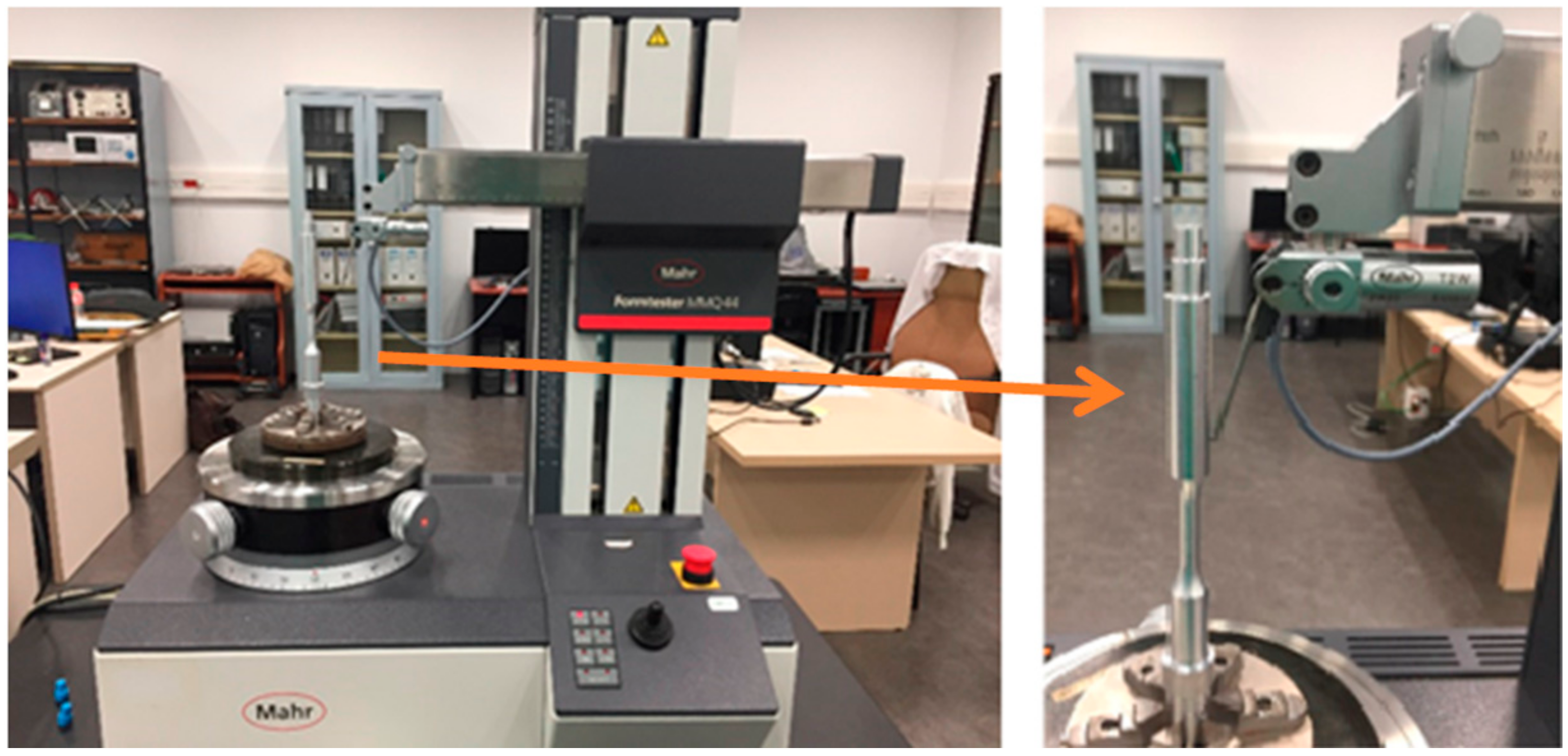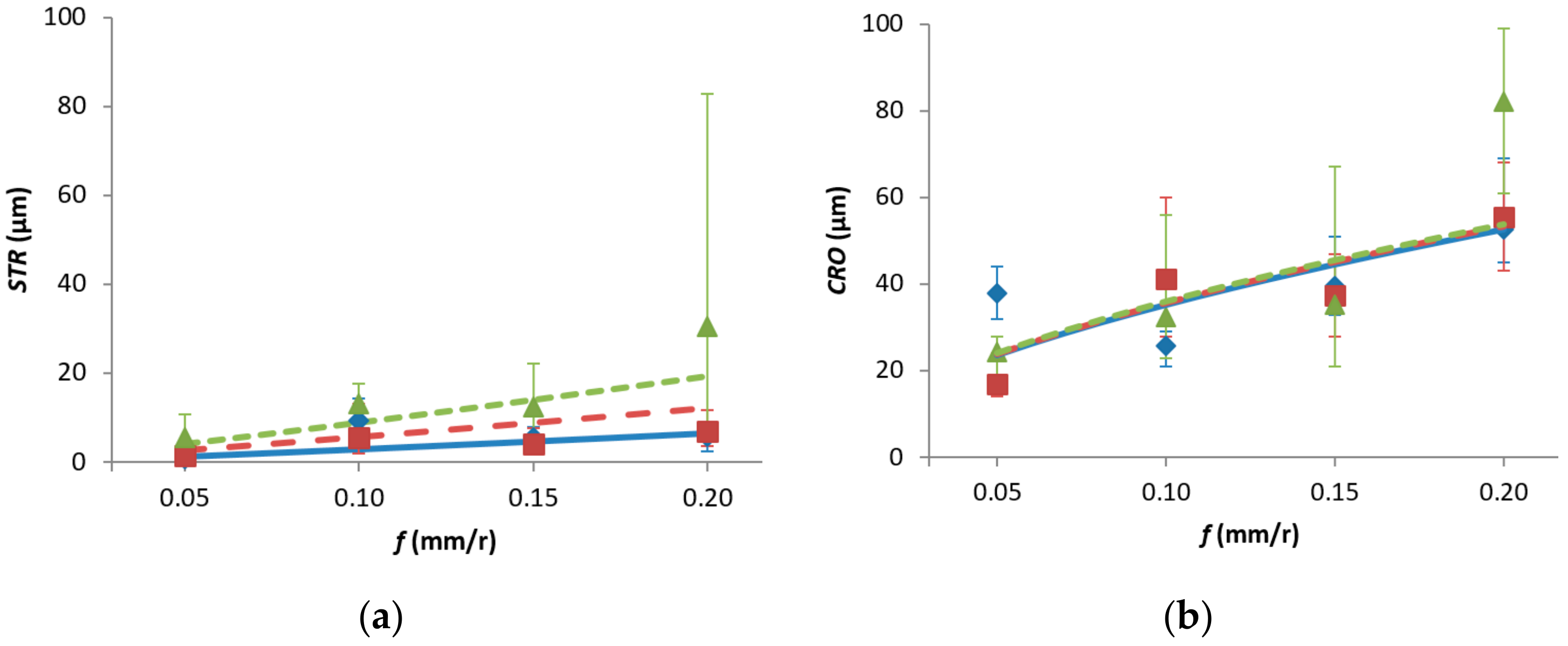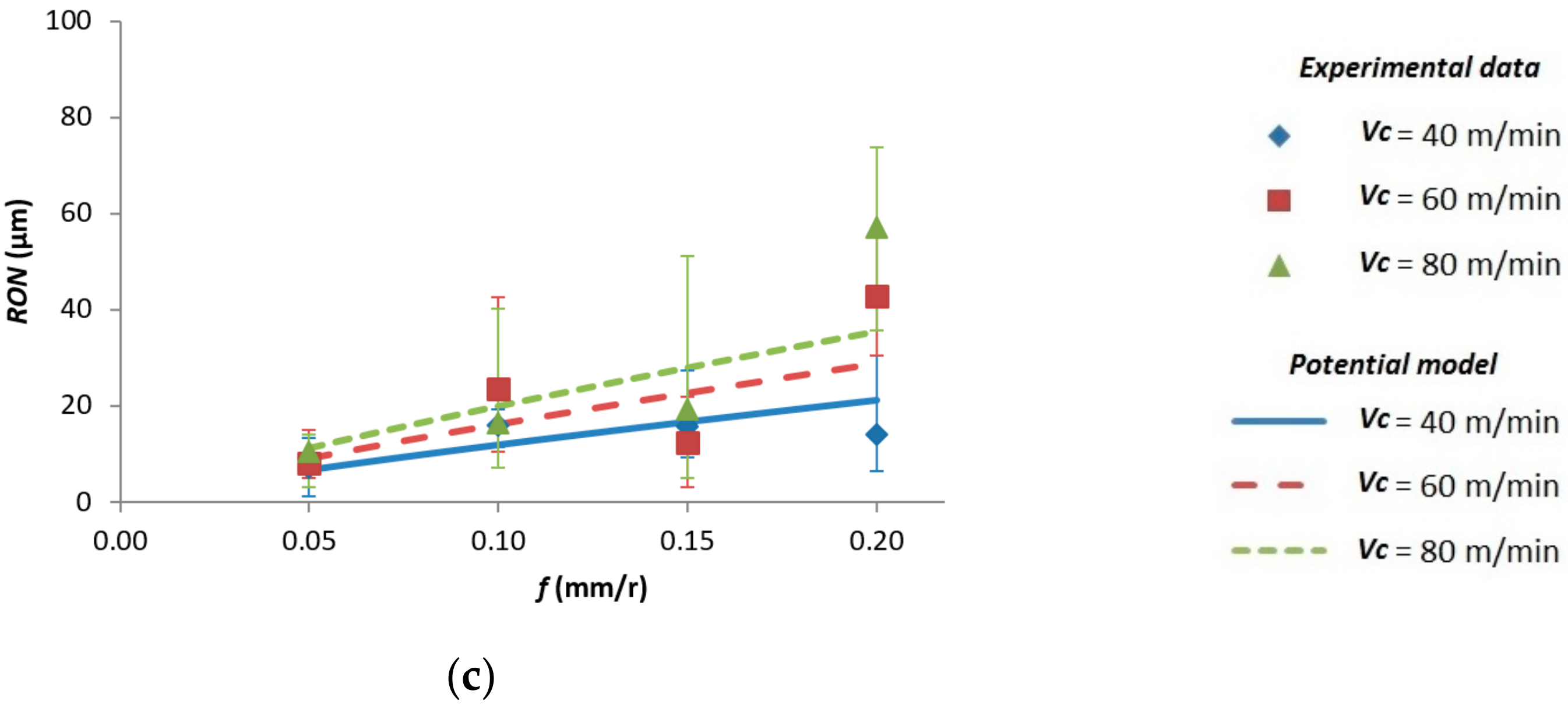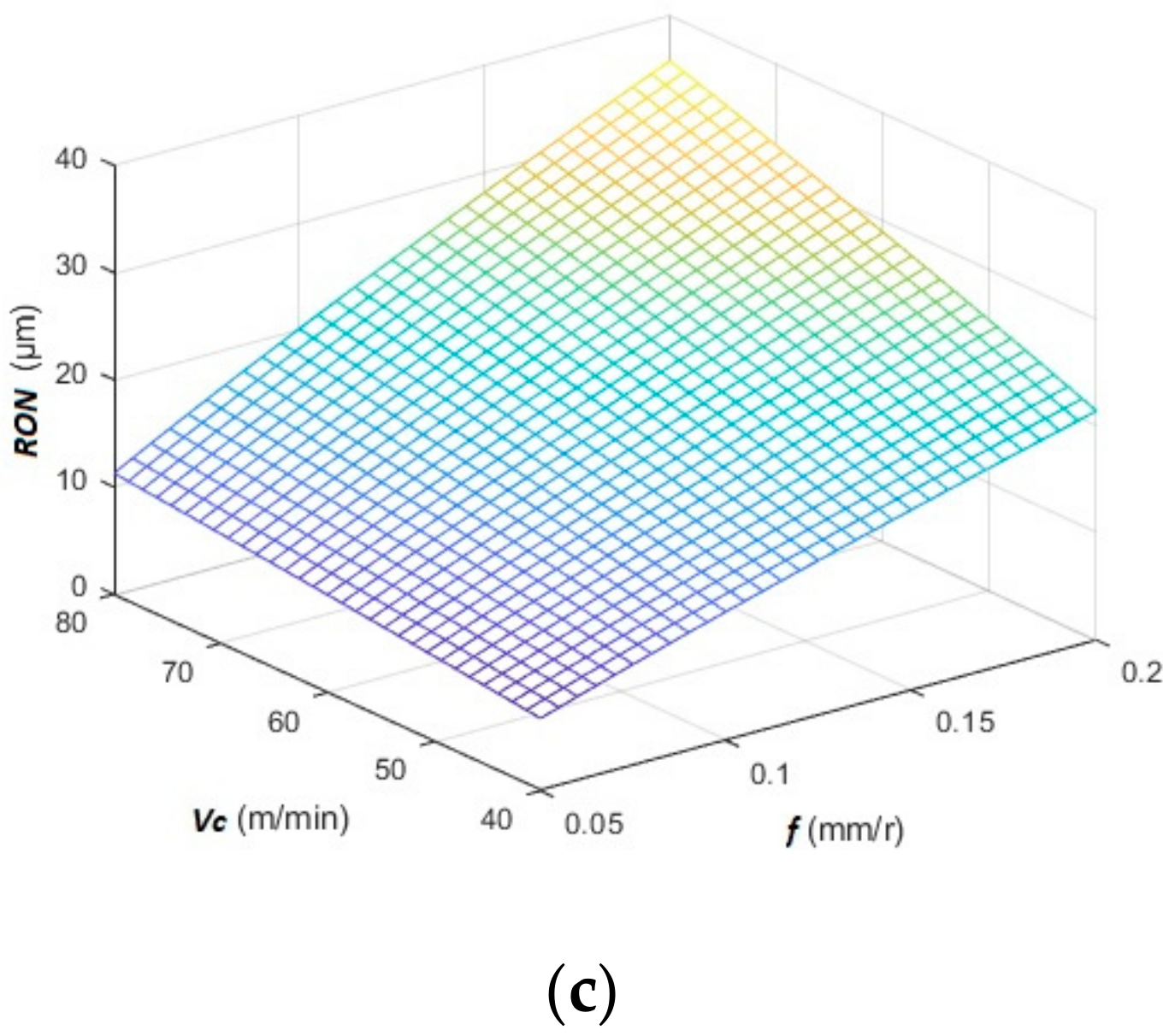Parametric Analysis of Macro-Geometrical Deviations in Dry Turning of UNS A97075 (Al-Zn) Alloy
Abstract
1. Introduction
2. Materials and Methods
- R: Radius of the profile
- xi: x coordinate of profile point
- yi: y coordinate of profile point
- a: x coordinate of the center of the least square circumference
- b: y coordinate of the center of the least square circumference
3. Results and Discussion
3.1. Parallelism and Straightness
3.2. Circular Run-out, Roundness and Concentricity
3.3. Total Circular Run-out and Cylindricity
3.4. Geometrical Tolerance in Rotating Bar Bending Specimens
3.5. Parametric Models for Macro-Geometrical Deviations
4. Conclusions
Author Contributions
Funding
Acknowledgments
Conflicts of Interest
References
- Grzesik, W. Introduction. In Advanced Machining Processes of Metallic Materials; Elsevier: Amsterdam, The Netherlands, 2017; pp. 1–5. [Google Scholar]
- Field, M.; Kahles, J.F. Review of surface integrity of machined components. Ann. CIRP 1971, 20, 153–163. [Google Scholar]
- Field, M.; Kahles, J.F.; Cammett, J.T. A review of measuring methods for surface integrity. CIRP Ann. Manuf. Technol. 1972, 21, 219–238. [Google Scholar]
- Griffiths, B. Manufacturing Surface Technology: Surface Integrity & Functional Performance; Butterworth-Heinemann: Oxford, UK, 2001. [Google Scholar]
- Astakhov, V.P. Surface Integrity—Definition and Importance in Functional Performance. In Surface Integrity in Machining; Springer: London, UK, 2010; pp. 1–35. [Google Scholar]
- Gómez Parra, A. Study of the influence of machining on the functional performance of aluminum alloys for strategic use in the aeronautical industry. Ph.D. Thesis, Universidad de Cádiz, Cadiz, Spain, 2016. [Google Scholar]
- Clares Rodriguez, J.M.; Vazquez Martinez, J.M.; Gomez-Parra, A.; Puerta Morales, F.J.; Marcos, M. Experimental Methodology for Evaluating Workpieces Surface Integrity in Dry Turning of Aerospace Alloys. In Proceedings of the Annals of DAAAM, the 26th International DAAAM Symposium, Zadar, Croatia, 18–25 October 2015; pp. 0849–0855. [Google Scholar]
- Risbood, K.A.; Dixit, U.S.; Sahasrabudhe, A.D. Prediction of surface roughness and dimensional deviation by measuring cutting forces and vibrations in turning process. J. Mater. Process. Technol. 2003, 132, 203–214. [Google Scholar] [CrossRef]
- Trujillo, F.J.; Sevilla, L.; Marcos, M. Cutting speed-feed coupled experimental model for geometric deviations in the dry turning of UNS A97075 Al-Zn alloys. Adv. Mech. Eng. 2014, 2014, 382435. [Google Scholar] [CrossRef]
- Abroug, F.; Pessard, E.; Germain, G.; Morel, F.; Chové, E. The influence of machined topography on the HCF behaviour of the Al 7050 alloy. Procedia Eng. 2018, 213, 613–622. [Google Scholar] [CrossRef]
- ISO 1143:2010 (E). Metallic materials: Rotating Bar Bending Fatigue Testing. Available online: https://www.iso.org/standard/41875.html (accessed on 28 September 2019).
- Javidi, A.; Rieger, U.; Eichlseder, W. The effect of machining on the surface integrity and fatigue life. Int. J. Fatigue 2008, 30, 2050–2055. [Google Scholar] [CrossRef]
- M’Saoubi, R.; Outeiro, J.C.; Chandrasekaran, H.; Dillon, O.W., Jr.; Jawahir, I.S. A review of surface integrity in machining and its impact on functional performance and life of machined products. Int. J. Sustain. Manuf. 2008, 1, 203. [Google Scholar]
- Martín-Béjar, S.; Trujillo, F.J.; Herrera, M.; Sevilla, L.; Marcos, M. Experimental methodology design for fatigue behaviour analysis of turned aluminum alloys. Procedia Manuf. 2017, 13, 73–80. [Google Scholar] [CrossRef]
- Apostolos, F.; Alexios, P.; Georgios, P.; Panagiotis, S.; George, C. Energy efficiency of manufacturing processes: A critical review. Procedia CIRP 2013, 7, 628–633. [Google Scholar] [CrossRef]
- Gómez-Parra, A.; Puerta, F.J.; Rosales, E.I.; González-Madrigal, J.M.; Marcos, M. Study of the influence of cutting parameters on the Ultimate Tensile Strength (UTS) of UNS A92024 alloy dry turned bars. Procedia Eng. 2013, 63, 796–803. [Google Scholar] [CrossRef]
- Trujillo, F.J.; Sevilla, L.; Marcos, M. Experimental parametric model for indirect adhesion wear measurement in the dry turning of UNS A97075 (Al-Zn) alloy. Materials 2017, 10, 152. [Google Scholar] [CrossRef] [PubMed]
- Starke, E.A.; Staley, J.T. Application of modern aluminium alloys to aircraft. Fundam. Alum. Metall. 2011, 747–783. [Google Scholar] [CrossRef]
- Santos, M.C.; Machado, A.R.; Sales, W.R.; Barrozo, M.A.S.; Ezugwu, E.O. Machining of aluminum alloys: a review. Int. J. Adv. Manuf. Technol. 2016, 86, 3067–3080. [Google Scholar] [CrossRef]
- Polmear, I.J. 3-Wrought aluminium alloys. In Light Alloys, 4th ed.; Butterworth-Heinemann: Oxford, UK, 2005; pp. 97–204. [Google Scholar]
- Trent, E.M.; Wright, J.R. Metal Cutting, 4th ed.; Butterworth-Heinemann: Oxford, UK, 2000. [Google Scholar]
- Campbell, F.C. Manufacturing Technology for Aerospace Structural Materials; Elsevier Science: Amsterdam, The Netherlands, 2006. [Google Scholar]
- Sugihara, T.; Nishimoto, Y.; Enomoto, T. On-machine tool resharpening for dry machining of aluminum alloys. Procedia CIRP 2014, 24, 68–73. [Google Scholar] [CrossRef]
- Goindi, G.S.; Sarkar, P. Dry machining: A step towards sustainable machining—Challenges and future directions. J. Clean. Prod. 2017, 165, 1557–1571. [Google Scholar] [CrossRef]
- Krolczyk, G.M.; Maruda, R.W.; Krolczyk, J.B.; Wojciechowski, S.; Mia, M.; Nieslony, P.; Bukzik, G. Ecological trends in machining as a key factor in sustainable production—A review. J. Clean. Prod. 2019, 218, 601–615. [Google Scholar] [CrossRef]
- Maruda, R.W.; Krolczyk, G.M.; Wojciechowski, S.; Zak, K.; Habrat, W.; Nieslony, P. Effects of extreme pressure and anti-wear additives on surface topography and tool wear during MQCL turning of AISI 1045 steel. J. Mech. Sci. Technol. 2018, 32, 1585–1591. [Google Scholar] [CrossRef]
- Chen, L.; Hsieh, C.-C.; Wetherbee, J.; Yang, C.-L. Characteristics and treatability of oil-bearing wastes from aluminum alloy machining operations. J. Hazard. Mater. 2008, 152, 1220–1228. [Google Scholar] [CrossRef]
- García-Jurado, D.; Vazquez-Martinez, J.M.; Gámez, A.J.; Batista, M.; Puerta, F.J.; Marcos, M. FVM based study of the influence of secondary adhesion tool wear on surface roughness of dry turned Al-Cu aerospace alloy. Procedia Eng. 2015, 132, 600–607. [Google Scholar] [CrossRef][Green Version]
- Trujillo, F.J.; Sevilla, L.; Martín, F.; Bermudo, C. Analysis of the chip geometry in dry machining of aeronautical aluminum alloys. Appl. Sci. 2017, 7, 132. [Google Scholar]
- Trujillo, F.J.; Sevilla, L.; Marcos, M. Influence of the axial machining length on microgeometrical deviations of horizontally dry-turned UNS A97075 Al-Zn alloy. Procedia Eng. 2013, 63, 405–412. [Google Scholar] [CrossRef]
- Gökkaya, H. The effects of machining parameters on cutting forces, surface roughness, Built-Up Edge (BUE) and Built-Up Layer (BUL) during machining AA2014 (T4) Alloy. J. Mech. Eng. 2010, 56, 584–593. [Google Scholar]
- Rubio, E.M.; Camacho, A.M.; Sánchez-Sola, J.M.; Marcos, M. Surface roughness of AA7050 alloy turned bars: Analysis of the influence of the length of machining. J. Mater. Process. Technol. 2005, 162–163, 682–689. [Google Scholar] [CrossRef]
- Horváth, R.; Drégelyi-Kiss, A. Analysis of surface roughness of aluminum alloys fine turned: United phenomenological models and multi-performance optimization. Meas. J. Int. Meas. Confed. 2015, 65, 181–192. [Google Scholar] [CrossRef]
- Jomaa, W.; Songmene, V.; Bocher, P. Surface finish and residual stresses induced by orthogonal dry machining of AA7075-T651. Materials 2014, 7, 1603. [Google Scholar] [CrossRef]
- De Lacerda, J.C.; Martins, G.D.; Signoretti, V.T.; Teixeira, R.L.P. Evolution of the surface roughness of a low carbon steel subjected to fatigue. Int. J. Fatigue 2017, 102, 143–148. [Google Scholar] [CrossRef]
- Novovic, D.; Dewes, R.C.; Aspinwall, D.K.; Voice, W.; Bowen, P. The effect of machined topography and integrity on fatigue life. Int. J. Mach. Tools Manuf. 2004, 44, 125–134. [Google Scholar] [CrossRef]
- Trujillo, F.J.; Sevilla, L.; Salguero, J.; Batista, M.; Marcos, M. Parametric potential model for determining the microgeometrical deviations of horizontally dry-turned UNS A97075 (Al–Zn) alloy. Adv. Sci. Lett. 2013, 19, 731–735. [Google Scholar] [CrossRef]
- Trujillo, F.J.; Marcos, M.; Sevilla, L. Experimental prediction model for roughness in the turning of UNS A97075 alloys. Mater. Sci. Forum 2014, 797, 59–64. [Google Scholar] [CrossRef]
- Salguero, J.; Puerta, F.J.; Gomez-Parra, A.; Trujillo, F.J.; Sevilla, L.; Marcos, M. An analysis of geometrical models for evaluating the influence of feed rate on the roughness of dry turned UNS A92050 (Al-Cu-Li) alloy. Adv. Mater. Process. Technol. 2016, 2, 578–589. [Google Scholar] [CrossRef]
- Sánchez Sola, J.M.; Batista, M.; Salguero, J.; Gómez, A.; Marcos, M. Cutting speed-feed based parametric model for macro-geometrical deviations in the dry turning of UNS A92024 Al-Cu alloys. Key Eng. Mater. 2012, 504–506, 1311–1316. [Google Scholar] [CrossRef]
- Benchergui, D.; Svoboda, C. Aircraft design. Aerosp. America 2012, 50, 28. [Google Scholar]
- ISO 1101:2017 (E). Geometrical Product Specifications (GPS)—Geometrical tolerancing—Tolerances of Form, Orientation, Location and Run-Out. Available online: https://www.iso.org/obp/ui/#iso:std:iso:1101:ed-4:v1:en (accessed on 28 September 2019).
- Sui, W.; Zhang, D. Four methods for roundness evaluation. Phys. Procedia 2012, 24, 2159–2164. [Google Scholar] [CrossRef]
- Wojciechowski, S. Machined surface roughness including cutter displacements in milling of hardened steel. Metrol. Meas. Syst. 2011, 18, 429–440. [Google Scholar] [CrossRef]



















| Zn | Mg | Cu | Cr | Si | Mn | Al |
|---|---|---|---|---|---|---|
| 6.01 | 2.61 | 1.88 | 0.19 | 0.08 | 0.07 | Rest |
| vc (m/min) | f (mm/r) | ap (mm) |
|---|---|---|
| 40 60 80 | 0.05 | 1.0 |
| 0.10 | ||
| 0.15 | ||
| 0.20 |
| Cutting Angles | Value |
|---|---|
| Relief angle (α) | 7° |
| Cutting edge angle (β) | 66° |
| Rake angle (γ) | 17° |
| Major cutting edge angle (κr) | 62.5° |
| Insert included angle (ε) | 55° |
| GD | C | x | y |
|---|---|---|---|
| STR | 0.120 | 1.574 | 1.123 |
| CRO | 119.720 | 0.028 | 0.584 |
| RON | 5.297 | 0.736 | 0.832 |
© 2019 by the authors. Licensee MDPI, Basel, Switzerland. This article is an open access article distributed under the terms and conditions of the Creative Commons Attribution (CC BY) license (http://creativecommons.org/licenses/by/4.0/).
Share and Cite
Martín Béjar, S.; Trujillo Vilches, F.J.; Bermudo Gamboa, C.; Sevilla Hurtado, L. Parametric Analysis of Macro-Geometrical Deviations in Dry Turning of UNS A97075 (Al-Zn) Alloy. Metals 2019, 9, 1141. https://doi.org/10.3390/met9111141
Martín Béjar S, Trujillo Vilches FJ, Bermudo Gamboa C, Sevilla Hurtado L. Parametric Analysis of Macro-Geometrical Deviations in Dry Turning of UNS A97075 (Al-Zn) Alloy. Metals. 2019; 9(11):1141. https://doi.org/10.3390/met9111141
Chicago/Turabian StyleMartín Béjar, Sergio, Francisco Javier Trujillo Vilches, Carolina Bermudo Gamboa, and Lorenzo Sevilla Hurtado. 2019. "Parametric Analysis of Macro-Geometrical Deviations in Dry Turning of UNS A97075 (Al-Zn) Alloy" Metals 9, no. 11: 1141. https://doi.org/10.3390/met9111141
APA StyleMartín Béjar, S., Trujillo Vilches, F. J., Bermudo Gamboa, C., & Sevilla Hurtado, L. (2019). Parametric Analysis of Macro-Geometrical Deviations in Dry Turning of UNS A97075 (Al-Zn) Alloy. Metals, 9(11), 1141. https://doi.org/10.3390/met9111141







